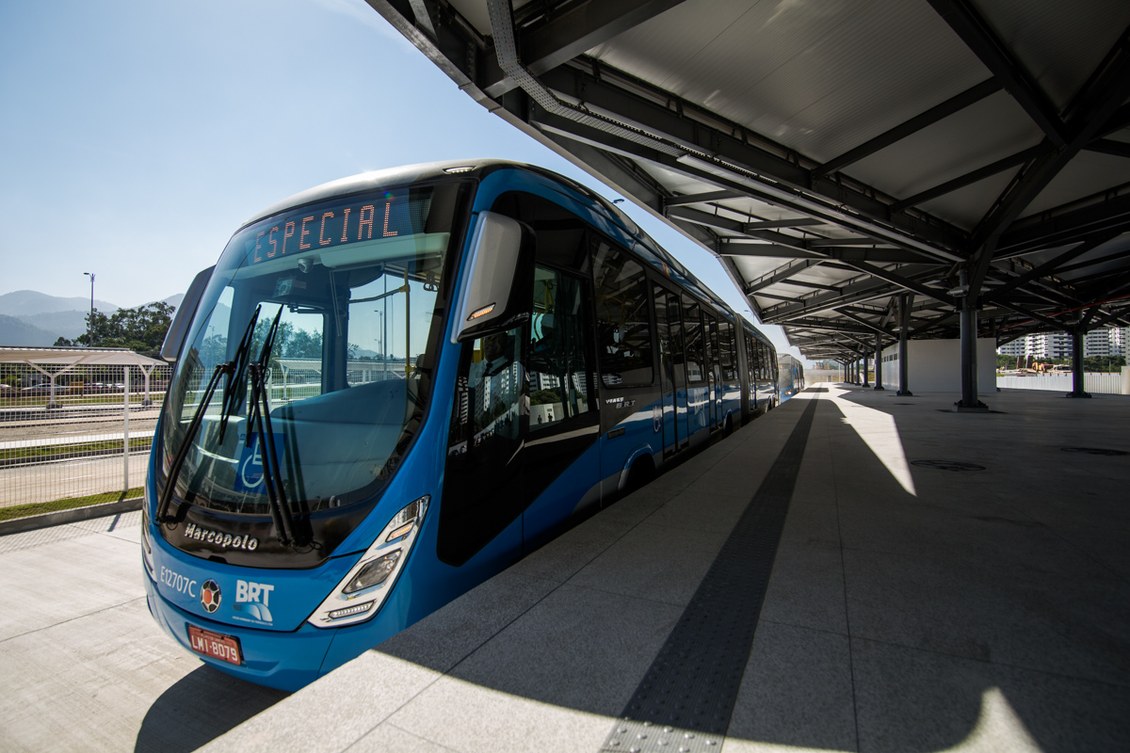Geral
Urban mobility
TransOlímpica Express Way cuts travel time between Barra and Deodoro by 60%
A group of journalists participated on Monday (04/07) in a demo trip of TransOlímpica, the new express way in the BRT (Bus Rapid Transit) network, which serves 11 districts in the West side of Rio de Janeiro. Once it becomes operational, this route will cut travel time between Recreio dos Bandeirantes and Deodoro from two hours to about 30 minutes.The TransOlímpica is 26 kilometres long and provides two lanes for cars and a dedicated bus corridor, which should benefit 70 thousand public transportation passengers per day, in addition to capacity for 55 thousand vehicles.
For the demo trip to media representatives, we left from the Recreio terminal. Strategic stations can be found along the way, such as the station near the Olympic and Paralympic Village and the station near Riocentro, an important competition venue in Barra da Tijuca. A non-stop trip to the Olympic Training Centre, across from the Olympic Park in Barra da Tijuca, takes 11 minutes. We got off the bus and walked around the terminal along with Mayor Eduardo Paes. Continuing the journey, we got into the stretch under a TransOlímpica concession and went straight to Deodoro. The non-stop journey between the Olympic Training Centre terminal and the Magalhães Bastos station, right in front of the Deodoro Sports Complex, took 19 minutes. From the station, you can take a dedicated line called "Circular Olímpica" to get more quickly to the Radical Park, which will be hosting cycling competitions (BMX and mountain biking) and slalom canoeing during the Rio 2016 Games.
We then went on to the Vila Militar station, also an option for spectators wishing to follow the competitions in Deodoro. Both stations - Magalhães Bastos and Vila Militar - are integrated into the SuperVia, thus allowing spectators to change to the railway system. On our way back to Recreio, the trip took just as long as the way there through the dedicated non-stop BRT corridor.
Use during the Olympics Games
TransOlímpica will be officially inaugurated next Saturday (09/07), but it will be used first by Olympic spectators: from 5 to 21 August, BRT will be available to spectators with an Olympic RioCard. The two lanes for cars will be used by authorised vehicles for the Games, in the so-called "Olympic family". From 22 August, the express way will be available to everyone, with a toll charge on the section under concession for the standard lanes. Users of the public transportation system will pay only the BRT fare.
In the section under concession, the Salvador Allende and Ambassador Abelardo Bueno avenues were widened in Recreio/Barra da Tijuca. The new route will have 41 new crossings between viaducts, bridges and overpasses, and will have 17 stations and five terminals. Six stations and two terminals will be used during the Olympic Games. Near the Olympic Park will be the Olof Palme, Morro do Outeiro and Riocentro stations, in addition to the Olympic Centre and Recreio terminals. In the area surrounding the Deodoro Sports Complex will be the Marechal Fontenelle, São José de Magalhães Bastos and Vila Militar stations.
"We know that 75% passenger flows will be from the Olympic and Paralympic Village either to the Olympic Park in Barra or to the Deodoro Park. And we'll have a very fast connection in order to avoid an excessive number of Olympic lanes that is always a problem during the Olympics. Athletes, members of the Olympic family and spectators will be able to travel around very quickly," said Mayor Eduardo Paes.
TransOlímpica is part of the Public Policy Plan for the Rio 2016 Games, and received funds worth R$2.2 billion from the Municipality of Rio de Janeiro. This is the third dedicated corridor for fast-track buses, and the second to cut across the city, adding to the Transoeste and Transcarioca BRT services, which have been in operation since 2012 and 2014, respectively. Together, the three corridors will account for more than half a million passengers per day.
Special services
Four special BRT services have been established for the Olympic period. The first is "Vila Militar - Recreio dos Bandeirantes", which will take spectators from Deodoro to competition venues in Barra/Recreio – the same route as the one for the demo trip in this second TransOlímpica route. The other special service – "Olympic Training Centre - Jardim Oceânico" – will connect the Olympic Park with the Jardim Oceânico station in the new Metro Line 4. Service "Olympic Centre - Vicente de Carvalho" will also provide a connection between the Olympic Park and the Metro, with the Vicente de Carvalho station in Line 2. Finally, the "Golfe Olímpico - Jardim Oceânico" service will run between the terminal station for Line 4 (Jardim Oceânico) and the golf course.
During the Games, the remaining BRT corridors will also have dedicated services for Olympic spectators with independent modules. The Transcarioca BRT service will have two stations (Madureira-Manaceia and Vicente de Caravalho) and the Transoeste service will have four stations (Golfe Olímpico, Barra Shopping, Bosque Marapendi, and Jardim Oceânico).
Carol Delmazo - brasil2016.gov.br


































